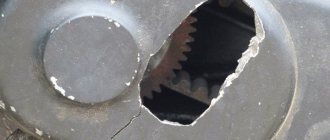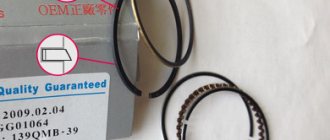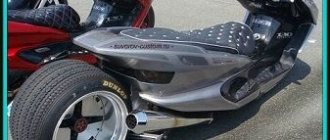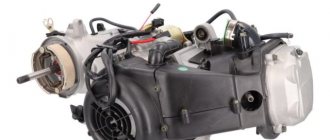Why install a tuning gearbox on a scooter?
Most scooter owners complain about the lack of top speed after tuning their scooter. That’s right, you improve the engine’s power performance, install a tuning switch that no longer cuts off engine speed, but the maximum you get from this is an increase in speed of 20-25 km and excellent dynamics.
In essence, you are tuning your scooter for dynamics in this way. Now it’s easier for him to accelerate, drag two people, and climb a mountain.
Modification of a Chinese scooter, a little about spare parts
Many scooter owners already after the first season have a desire to start modifying their pet . Tuning in our country has long become almost a national pastime. Owners of Chinese cars are no exception to the general rule. They try to increase their power, reduce weight, and improve other performance indicators of their pets. To do this, they equip their equipment with various additional parts. In addition, tuning can also include replacing standard components and mechanisms with better ones.
Tuning the gearbox for a scooter
- Motorcycles
- Jawa Reviews/Tests
- IZH
- Minsk
- Ural/Dnepr
- Sunrise
- Scooters
- Jawa
- Jawa
- VAZ
- VAZ
- VAZ
- Motorcycles
Calendar
friends of site
Tuning the gearbox of a Chinese scooter with a 139QMB engine
Tuning a scooter, in addition to the obligatory increase in dynamics, also provides for an increase in maximum speed. To achieve the coveted increase of 15-20 kilometers per hour, you need to either rev the engine to high speeds or replace the gearbox. In the first option, in order to ensure the durability of the engine as a whole, it is necessary to stock up on high-quality parts that will easily withstand increased loads. However, this is quite expensive and not advisable, especially on 139QMB engines.
A simple way to increase the maximum speed when increasing the piston on scooters with a 139QMB engine can be considered the move to replace the gearbox gears with tuning ones. It is known that a scooter's gearbox reduces the speed of the variator, increases torque and transmits it directly to the rear wheel. The gearbox consists of a set of gears and shafts. Each gear has a certain number of teeth, and this number is calculated by engineers in such a way that a scooter with a certain cubic capacity feels most efficient throughout the entire speed range.
After increasing the piston, the gear ratio of the gearbox is no longer relevant; for the new power it becomes “short”. This means that you will accelerate to the coveted 60 kilometers per hour much more energetically, compared to the stock piston engine, and the scooter will feel much more confident with a passenger, but in this case there is no increase in speed, because the engine speed remains at the same level. Replacing the scooter's gearbox with a tuning one can solve this problem. You can select the most optimal set of gears and replace them yourself, after which the speed will certainly increase, but the dynamics in this case will remain at the stock level.
Each scooter owner must decide for himself what is more important to him, speed or dynamics, and after that start replacing the gears. In some cases, you can achieve a positive effect in both directions, however, after fine-tuning the variator (preferably with a tuning one) and other engine parts as a whole. It all depends on the budget and the tasks assigned to the scooter. Let's consider the main provisions for increasing maximum speed.
How to increase the maximum speed of a Chinese scooter with a 139QMB engine.
The most budget-friendly option for increasing the maximum speed on a Chinese four-stroke scooter with a 139QMB engine can be considered a number of the following changes:
- Replacing the stock 50 cubic centimeter piston with a larger one, usually 82 cubic centimeters with a piston diameter of 50 mm. You can't do without adjusting the carburetor.
- Replacement of old gears of the reducer with an intermediate shaft with new ones. Typically, a stock 139QMB engine is equipped with a secondary pair of gears with a gear ratio of 0.29 and 15x52 tooth gears. By replacing them with tuning ones, the gear ratio of which is 0.35, and the number of teeth of the secondary pair of gears is 17x49, we get an excellent platform for realizing an increase in speed of up to 20%. Modern online stores are already equipped with similar parts and you can easily order them without leaving your home, for example here. The store is proven and has never let you down. Conveniently, they have the gear already pressed onto the intermediate shaft and all you have to do is replace the old parts with new ones. Replacing the original variator with a tuning one. This way you can achieve confident traction throughout the entire rev range and achieve the desired speed. This option can be neglected if after the first two points you have achieved what you wanted. The process of tuning the gearbox on a scooter is quite simple. If you have the skills to replace a CVT, CPG and other parts, replacing the gears will be an easy task. The design of the 139QMB engine allows access to the gearbox only after removing the rear wheel, removing the variator cover and clutch. Before doing this, you need to drain the old transmission oil. You need to drain the oil while it is “hot”, preferably after a trip so that the gearbox is hot. Sometimes you will need an impact driver to remove the screws.
- Replacing gears on a 139QMB engine
Tuning of Chinese scooters 2t, 4t, 50cc, 150cc
Writing about tuning scooters is like ignoring Kozma Prutkov’s warning and trying to embrace the immensity.
Therefore, in this material I will touch on a narrow and topical topic - tuning four-stroke “Chinese” ones. First, I’ll warn you against possible reproaches, like Chinese technology cannot be tuned, it falls apart on its own, etc. So, in large letters: THE CHINESE MOTOR INDUSTRY, IN THE PERSON OF ITS BEST REPRESENTATIVES, HAS GROWED TO THE SOLUTION THAT ITS MOTORS DO NOT FALL UP AFTER THE TUNING PERFORMED ON IT. At least right away. Realistically, without joking, this is an achievement; if you had written like this a couple of years ago, they would have laughed at you. Another digression - a few lines of educational information, this is for those who are far from the topic, or have just embarked on this thorny path. Experienced tuners (or tuners - as you like, but not to be confused with toners and tuners) can skip this block without damage to themselves.
LIKBEZ Globally, scooter tuning can be divided into measures for: – increasing engine power , from removing standard “stranglers” (if any) to, first of all, increasing its cubic capacity; – transmission settings for changed engine parameters or when the manufacturers themselves “messed up” (that is, they did not properly adjust the variator). In both the first and second directions, the components and parts for tuning two-stroke and four-stroke engines are fundamentally different. What I mean is that it would be nice to know what it is.
Here is a short list of what they usually put their hands on when professionally tuning an engine: CPG, that is, the cylinder-piston group (it includes a piston with a cylinder, and the pin, rings, stoppers like them), cylinder head, carburetor, air filter, exhaust system and reed valve (for two-stroke engines), electronic ignition unit. In the transmission, the following are subject to tuning: the variator clutch assembly, weights, belt, rear half-pulleys, driven pulley spring, springs and the “bell” of the centrifugal clutch. In addition, they carry out tuning of the chassis (suspension, tires, brakes) and decorative tuning, also known as styling. And one more thing: it is impossible to achieve tangible results (except perhaps with a minus sign) by tuning one engine and without interfering with the operation of the transmission.
Now let's move on to what is on our market. I think I won’t discover America for anyone (but I can’t help but say this): all Chinese “air” four-stroke engines are practically the same. Their prototype was a Honda engine coded GY6. What is it?
Here it is, the original - the Honda GY6 engine.
As you know, Honda Motor Company improved the design of the scooter engine in the 1960s. Relying on that technology, the more advanced Honda GY6 engine was produced in the 1980s. It is four-stroke, single-cylinder, air or air-oil cooled, standard with two overhead valves. Power in the stock version of 125-150 cc models ranges from 7.8 hp. (5.8 kW) to 12.4 hp (9.2 kW). And forced engine modifications can develop up to 14 hp. at 12,000 rpm.
The GY6 engine is coupled with an automatic CVT transmission (variator). This engine was initially produced in capacities of 50, 125 and 150 cm3 and was installed on scooters of the (CH125/CH150) Elite and Spacey families.
The execution of “125” and “150” differs slightly from that of “fifty kopecks”.
Scooter of the CH125/CH150 Honda Elite family.
Today, Honda no longer uses these engines in their scooters (they have moved on - liquid cooling, fuel injection), but Chinese, Korean, and Taiwanese clones of this engine are produced in huge numbers. In China alone, where there are more than a hundred scooter companies, each has a copy of the GY6 in its arsenal. Because of this engine's widespread suitability and low cost, Asian ATV manufacturers began using GY6 clones in their children's ATVs and buggies (from road go-karts to off-road vehicles), 150cc youth quads, and even children's snowmobiles.
Due to the wide distribution of the engine in both older Honda models and new Asian imports, you can find a lot of information on the Internet about modifications, available components and parts. User forums such as buggy news go karts and off road buggy forum or scootdawg forum allow you to discuss the problems of these engines, repair methods and tuning (though for those who are fluent in English). Users on these forums have experienced many modifications from third party countries, such as four-valve heads with high compression ratios, big displacement kits, upgraded CVTs, CDI racing ignition units, carburetors, and exhaust kits.
I would like to express my respect to Chinese manufacturers: the country has introduced a clear standardization system in designations, and all manufacturers follow it. Otherwise there would be such confusion! Here are the basic types of Chinese scooter engines : 139QMB (bore x piston stroke 39x41.5 mm, displacement 49.6 cm3), 152QMI (52.4x57.8 mm, 124.6 cm3) and 157QMJ (57.2x57.8 mm, 148.5 cm3). As you can see, in their digital code, if you remove the one, the diameter of the cylinder is encrypted. Within each type, the main parts of the cylinder-piston group (CPG) are interchangeable, and with minimal tolerances. That is, you can safely install parts from one manufacturer on a unit from another. Thanks to this property, you don’t need to bother searching for parts (either for repair or for tuning) for any specific brand.
Lifanovsky clone 152QMI.
Now, perhaps, about the most important thing - who produces the desired sets and how accessible they are . Previously, advanced scooter riders were familiar with tuning kits (they are also called “whales”, from the English Kit - set) of Italian (Polini) and “Malossi”. Their range is extensive, it includes not only repair kits and tuning kits for European two-stroke scooters, but also for common Japanese cars. However, all this tuning from “Malossi” is expensive, from “Polini” it is even cooler, despite the fact that the “whales” still sailed from China and Taiwan. And besides, today there are an order of magnitude more new “Chinese” on our roads than vehicles from Europe or Japan. It is not surprising, therefore, that “whales” began to sail to us from Asia directly, and not from Europe, bashfully covered up by famous European brands and at European prices. Let everyone know where the tuning drummers live - on the island of Taiwan. Why in Taiwan? There, the highest degree of scooterization of the population (21 million scooters per 25 million inhabitants) has given rise to a special attitude towards this technology, and Japanese and European technologies make it possible to maintain a high level of production. In addition, the lack of heating costs and people’s unpretentiousness in everyday life and food make the price of products humane even for such a poor country as Russia has become. Remember these brands Koso, CM Racing, YMS Racing, RPM, NHRC, perhaps they (or dozens of others) will soon surpass the “Italians” in popularity.
A small part of the abundance from Taiwan is available in Russia.
Almost all available kits for the “Chinese” include kits to increase cubic capacity, most of them in the “fifty kopecks” group. So, instead of a standard piston and cylinder with a diameter of 39 mm, you can find them with a diameter of 44 mm (under 63 cm3), 47 mm (72 cm3) and 50 mm (81.5 cm3). It seems that the most extreme set has appeared - with a diameter of 51.5 mm and 86.2 cm3. And yet, what comes to us for Chinese 4T engines cannot be compared with the racing high-tech that is produced for European or Japanese two-stroke scooters. There they are sharpened for racing at a high, almost professional level (to be even more precise, tuning there is usually divided into three levels). All tuning of the “Chinese” actually comes down to an increase in cubic capacity and a corresponding (God willing) increase in power and torque, and then the simplest adjustment of the variator. The rule applies - the greater the deviation from the nominal value, the more extensive the “whale” (or something else needs to be purchased) and the greater the amount of work. So, if with a 44 mm piston you can leave the original cylinder head, then for a 47 mm piston you need a different head and the jet must be recalibrated.
Preliminary work
Before repair work, the most initial, necessary diagnostics of engine components, inspection of repair accessories, assessment of weather conditions, etc. are carried out. To summarize, the list of preliminary work is as follows:
- The motor of the bike must be cold; it is advisable not to ride it before repairing;
- It is necessary to clean the engine elements from soot and dirt in advance, since dirt can get inside the valves;
- The temperature in the garage (or other place where repair work is carried out) must be above zero;
- The bike is rigidly fixed on the stand or in other convenient ways;
- The necessary set of keys and containers are prepared and are at hand.
Analogues - engine 1P39QMB
Chinese developers have created an analogue of the Japanese 139QMB engine - a motor labeled 1P39QMB, which in appearance completely replicates the original. Despite all the similarities, you can still find differences: the valve clearances on the 1P39QMB are not adjustable. The situation is similar with the carburetor: before direct operation it requires thorough cleaning and correct adjustment. Chinese copies of 139QMB engines, of course, cope with their task, but their main purpose was to reduce the final cost of motor vehicles. Budget versions of scooters are equipped with exactly the same versions of engines that are good only for short trips at low speeds.
Before starting operation, be sure to carry out a full run-in of the 1P39QMB engine. The optimal operating mode of the engine begins only after 2 thousand kilometers, but after 10 thousand kilometers all its technical characteristics drop, and it loses dynamics and power.
Installing piston rings
Remove the set of piston rings from the box. A piston ring set for a Chinese four-stroke scooter usually consists of five items. Three of which are a single assembled oil scraper ring, the other two: upper and lower compression.
A typical set of piston rings looks something like this
Carefully unpack the kit with perfectly clean hands.
In the kit you will find two of the thinnest rings and one thick corrugated ring (expander) - this will be an assembled oil scraper ring that needs to be installed on the piston first.
We place an expander in the lowest groove of the piston
We place thin oil scraper rings in the same groove - one under the expander, the second on top of the expander
We find the lower and upper compression rings in the kit and install them, respectively, in the middle and upper grooves of the piston - with marks on the side surface to the cylinder head (cylinder head). The lower compression ring differs from the upper one in color (not always) and the shape of the working edge (always). In most kits, the lower compression ring is painted black, and its working edge has a slight bevel.
The top compression ring in the vast majority of piston ring sets is a uniform light color. But this is in most cases, but in practice it happens that the kit comes with upper compression rings that are black or even red
By and large, the color is not particularly important to us, something else is important to us: the working edge of the upper compression ring has small roundings (chamfers) on the sides, and the working surface of the edge of the upper compression ring is covered with a shiny protective coating
For example, in this kit both compression rings are black. But the working surface of the upper compression ring is covered with a layer of protective coating, and small chamfers are removed on the edges of the working surface.
The lower compression ring has a matte working surface, and the working edge is beveled at a slight angle. All these moments are clearly visible in the photo.
The compression rings in this kit are red and black. As in the first case, the upper compression ring has chamfers on the working edge and a protective coating, and the lower one has a matte working edge beveled at an angle.
On classic piston ring sets, the upper compression ring has a light color and a rounded working edge. The bottom is dark in color and the working edge is beveled at a slight angle.
Cleaning the cylinder from carbon deposits and filing down the cylinder window
After their first season of riding a scooter, many people have a desire to start upgrading the hardware. Some, having disassembled the engine and seeing that everything is in excellent condition, stop there. But if you look closely (especially in the case of a Chinese scooter), it is quite possible to detect casting defects in the exhaust channel and carbon deposits stuck to the rough surfaces (as happened in our case, see photo). In this case, it is simply necessary to polish and clean the cylinder (carbon deposits create resistance to the flow of exhaust gases, and therefore reduce power).
Piston installation
Insert a retaining ring into any boss of the piston pin. It is most convenient to insert the ring with small round nose pliers. After installation, check how well and tightly the retaining ring fits.
- If the retaining ring does not cover the entire surface, but only a small part of it, replace it with a new one.
- If the retaining ring does not lie tightly in the groove and dangles, straighten it a little
Lubricate the bearings of the lower and upper connecting rod heads and the piston pin bosses with clean engine oil. We put the piston on the connecting rod, orienting it with the “IN” mark to the inlet port; if there is an “arrow” on the piston instead of the “IN” mark, orient the arrow to the exhaust port. We insert the piston pin into the boss - orient the piston on the connecting rod so that the pin hits the connecting rod - install the pin all the way into the locking ring and secure it from falling out with the second locking ring.
We install the cylinder guide bushings on the studs and put on the gasket. It is advisable to place the gasket on the sealant, but without fanaticism.
Dismantling the engine 157qmj 150 cc
As you remember, I set myself the goal of disassembling the 157qmj piston engine without removing the power unit itself from the scooter.
So, we remove the carpet, the seat, the trunk (toilet), the plastic near the seat, and then the exhaust pipe, leaving the muffler in place.
I advise you to tighten all the bolts in place, since some of them are of different lengths, and it is simply impossible to remember the location of each of them!
Now remove the air filter assembly and carburetor. By the way, we will also replace the filter, since its throughput will be insufficient for a 170cc cubic capacity. Instead we will install a red 38mm UniFilter.
Removing the 157 QMJ carburetor is easy, just release the fuel hoses from the clamps, disconnect the throttle cable and the starter enrichment wires. We are also replacing the stock carburetor with a 24mm intake pipe.
The QMJ 157 engine is covered with plastic casings - this allows additional circulation of the cooling air flow and protects the engine from dirt. By unscrewing a few screws we can easily remove the plastic. I advise you to throw old rags on the floor, which would absorb drops of oil from the engine and also prevent dust from rising. The workplace must be clean!
We remove the cover with the rubber gasket of the 157 qmj gy6 cylinder head by unscrewing four 8 mm bolts. The breather hose that was originally connected to the air filter will now be connected to the new oil trap (more on that later).
We unscrew the four nuts (12 mm) securing the camshaft bed, cylinder head and cylinder. Carefully remove the upper part of the camshaft bed, holding it.
Before removing the camshaft, unscrew the chain tensioner adjustment cap and loosen the tensioner itself (with a small flat-head screwdriver clockwise) and remove the timing chain from the camshaft sprocket.
Unscrew the two bolts and remove the tensioner.
In order to remove the 157QMJ cylinder head, you need to unscrew two more 8 mm bolts. Carefully remove the cylinder head.
Remove the cylinder from the studs. The metal gasket cannot be reused.
Using thin pliers, remove the piston pin retaining ring and separate the piston and connecting rod.
Due to the greater height of the 4-valve cylinder head, it is necessary to replace the 4 studs on which the CPG and cylinder head are twisted.
How to correctly install the studs of a 157qmj cylinder? The original studs are unscrewed using two nuts screwed onto the stud. You need to unscrew the bottom nut counterclockwise. When screwing in new studs, lubricate the threads with blue thread sealant. The two bolts on the right side of the engine that secure the cylinder do not need to be replaced.
Features of setting up the carburetor of a 2-stroke scooter
Some mopeds have their own characteristics. Perhaps the simplest carburetors are made in China. And a 2t scooter has a simpler carburetor than a four-stroke. Adjusting such a model should not be a serious obstacle. However, there are some peculiarities here too.
It should be noted that the needle in the 2t carburetor determines the quality of the mixture only while the throttle valve is not raised all the way. Otherwise, the fuel jet has a much stronger effect
There is also a connection with the idle system, but not on all models.
In 2T carburetors, the fuel level is much more significant than in 4T carburetors. You can set up the float chamber according to the instructions above; there are no significant differences, although the jets are different.
Approximate prices for tuning Chinese scooters in Moscow
This is what the SEARCH EXTREME service writes on its website, but this is cheap chatter; you can’t achieve this with such a sum. And this is just a trick, it’s better not to contact them at all, they can only ruin your scooter.
The first and most important thing in tuning scooters is to find and correctly remove speed limiters and “chokers”. In principle, Chinese scooters supplied to Russia may not have such limiters at all, whereas according to European laws, a scooter that does not have the right to reach speeds of more than 50 km/h is equipped with such devices. Therefore, tuning of Chinese scooters supplied from China practically does not concern speed as such.
When starting to tune a stels scooter, it is important to identify the speed limit method. This could be a limiter in the variator, a limiter in the commutator, a chip in the carburetor. Some manufacturers restrict the exhaust pipe (tuned pipes also have this), inserting draft-reducing whistles and catalysts there. In the last two cases (a chip in the carburetor or a whistle in the exhaust pipe), the initial tuning of the scooter is not very difficult.
Thanks to tuning, the moped stands out in the crowd and significantly gains in power. Transforming a standard model into an exclusive one will probably cost more than purchasing a scooter of a higher class.
Once the speed limiters are eliminated, we can say that the original goal of tuning a scooter has been achieved.
Scooter tuning is not performed to violate the speed limit. Most “jammers” choke the engine, preventing its owner from “getting everything out of the scooter.” Riding a moped with such a “jammer” is equivalent to driving a car at two speeds or with a half-clogged exhaust pipe. But besides the technical aspects, you want to enjoy riding a scooter. This is why scooter tuning is done.
Source: scooter digest, ironhorse, scootermag, scooter-news
Source
Engine tuning 139qmb
Before you start tuning a scooter, you need to think a hundred times about whether you are ready to sacrifice the stable operation of a 139qmb engine for the sake of speed? If yes, let's get started! I’ll say right away that tuning the 139qmb engine needs to be carried out “at once”, that is, you will have to change at once, if not everything, then a lot.
You should start by increasing the engine cubic capacity. To do this, we change the standard piston to 82cc. In this case, the main thing is not to forget to install a new cylinder head with larger valves. And of course, there is no point in changing the piston without replacing the camshaft... Since for the correct operation of our enlarged piston we will need an increased amount of air-fuel mixture. The changed shape of the cams of the new camshaft tuning will help us with this, but we cannot do without replacing the carburetor.
The standard carburetor can be thrown away; even replacing the jets will not help it. We will install a budget CVK18 with an 18mm diffuser. The diffuser is suitable, but with the jets everything is not so smooth. I advise you to immediately buy a set of jets of different sizes, since setting up a carburetor is a delicate matter.
Of course, you can install a zero-resistance filter, or completely remove the filter element from the standard filter by adding air to our fuel mixture. But all this sooner or later leads to carburetor contamination. My advice is to simply remove the 4 hole plug that is located at the air inlet of the air filter. At least this is the least destructive option for the carburetor.
The first thing you need to do is install an enlarged belt, this will allow you to fully use the potential of our standard variator. Read this article about how to choose the right variator belt. In addition to the belt, you should think about buying new weights, or rather a whole set of weights of different weights. Selecting the required weight of the variator weights is a painstaking task. Let me remind you that the acceleration dynamics and maximum speed of the scooter depend on their weight.
Everything is simple here, we just buy a switch without speed limit. Of those offered on the market, we will choose a universal tuning switch for a 139qmb four-stroke engine, which you can buy here - “CDI tuning”
The proposed manipulations with the 139qmb engine are one of the tuning options and are the least expensive. Why did I describe exactly this kind of “budget” tuning? - Of course, it would be possible to install a Malossi multivar variator, a CPG from a renowned manufacturer, a Keihin-type carburetor, and so on - but all these are unreasonable costs, since it was initially cheaper to buy a scooter with a 157qmj - 150cc engine. ← Zero resistance air filter: pros and cons Proper engine break-in →
Chinese scooter tuning and prices
Scooters produced by foreign manufacturers have a number of design limitations. First of all, the restrictions relate to the speed and power of the engine. For European consumers, the scooter's speed is limited to 50 km/h. Scooter tuning is designed to remove these restrictions. For what? To break traffic rules? Not at all.
The factory-limited power helps the engine operate in a gentle mode. And, consequently, its service life increases, the mechanical load on components and mechanisms decreases. Tuning scooters or tuning a moped definitely reduces the reliability and life of the engine .
What oil should I use?
Available types of oils for four-stroke engines: SAE 5W-20 or 10W-40. Depends on the manufacturer. If the vehicle is often operated in high temperature conditions, it is better to choose a motor oil with a high viscosity index.
What to look for when choosing oil? First of all, on the oil indices, which should be present on the canister label. The chemical composition is also no less important. In addition to the index, the exact amount of additives from the fluid manufacturer is used.
For a four-stroke scooter engine, you can use not only oil that is intended for scooters, but also for equipment: walk-behind tractors, lawn mowers, chainsaws and others.
Installing the timing chain tensioner
If you have a 157QMJ series engine, do the following: unscrew the plug on the tensioner body; We insert a thin flat screwdriver into it and begin to tighten the bolt until the tensioner rod goes inside the body.
Without releasing the screwdriver while simultaneously holding the tensioner body, with your free fingers, insert the tensioner into the cylinder, screw it in with bolts, and only then release the screwdriver and screw the plug into place.
If you have a 139QMB series engine, then do this: unscrew the plug from the tensioner housing and remove the spring; push the rod inside the body; install the tensioner in the cylinder; insert the spring into the housing and screw in the plug.
After installing the piston, do not forget to adjust the thermal clearances of the valves and break in the engine.
Motor assembly 157QMJ
Installation of gaskets and rings
The most important part of the assembly was making sure the spacers and rings were aligned correctly. Pay attention to the channel in the cylinder - install the gasket without blocking this channel, as it allows oil to lubricate the cylinder head. The gaskets were treated with a special Hylomar sealant, which provides a good seal and prevents engine oil leaks.
compression rings have a designation (T1 - upper, T2 - lower), with which they need to be installed towards the top. The bottom three rings (not marked) form the oil scraper ring, a wavy ring sandwiched between two metal rings. All three rings must be placed so that the gaps between them are at a distance of 120º. This can be achieved by conditionally dividing the piston into three even parts (approximately like the letter Y). The main thing is to ensure that none of the ring spaces coincide with one another, to prevent compression and oil leakage.
Engine Features
The official manufacturer of the 139QMB scooter engine is Hongling Corporation, which equips motorcycles not only of its own brand, but also of other brands with this engine.
The corporation sells power units to other manufacturers. The motor itself is very recognizable: the design features of the 139QMB engine and its markings on the left side of the crankcase immediately make it clear what kind of heart beats the scooter.
The motor has no flaws, does not require special treatment and calmly tolerates minor negligence and negligence. The manufacturer provides a guarantee for its products that covers the first 5 thousand kilometers. This mileage is enough for the new 139QMB 4t scooter engine to fully run in and grind in all elements and components of the systems.
The total service life of the engine is about 20 thousand kilometers, with the exception of 5 thousand running-in at an average driving speed of 90 km/h. The technical characteristics of the 139QMB engine are not bad: its power is enough for a two-seater full-size scooter.
Running in the engine
Incorrectly carried out running-in of the 139QMB engine in most cases leads to failure of the piston system. Friction occurs between the parts of the new CPG, which leads to an increase in engine temperature.
Running in the scooter motor is carried out as follows:
- The scooter is placed on the center stand.
- Within 5 minutes the engine starts at idle speed, the field of which cools down during the same time.
- Over the next 10 minutes, the engine also runs, after which it cools down for 15 minutes.
- The engine is restarted for 15 minutes, then turned off and left to cool for 15 minutes.
- The scooter is started again for 30 minutes, after which it is turned off and left for 20 minutes.
After carrying out such manipulations, you can run in the scooter itself. In the first 100 kilometers of the journey, you should not turn the throttle handle more than 1/3 of its full stroke. The maximum speed should not exceed 30 km/h. The speed can be increased by 15–20 km/h for the next 300 kilometers - during this time the engine should more or less reveal its potential.
After this break-in process, the oil must be changed.
Engine valves are adjusted every 500 kilometers.
Setting the valve timing ch2 (in collective farm style - ignition)
Without knocking the piston off from TDC, we orient the camshaft so that the large hole and marks on its sprocket become as shown in the photo and, while putting on the chain, install the camshaft in bed.
Ideally, the marks on the sprocket should be strictly parallel to the plane of the valve cover connector. In practice, unfortunately, such accuracy is difficult to achieve. And this is mainly due to the stretching of the timing chain. And there’s nothing you can do about it - either change the timing chain to a new one or catch the phase by switching the teeth, but this method of setting the valve timing is not acceptable to me personally.









